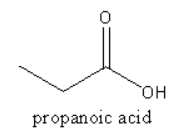
Propanoic acid occurs naturally as a result of the bacterial fermentation of milk and is partly responsible for the flavour of Swiss cheese.
Which starting materials can be used to produce propanoic acid?

A.
B.
B.
D.

Answer
479.4k+ views
Hint:The given reactant contains alcohol, aldehyde, and nitrile, functional group. We will convert them into carboxylic acid by using oxidizing agents. Oxidizing agents cause oxidation hence converts alcohol, aldehyde, and nitrile functional groups into a carboxylic acid.
Complete answer:
We have to prepare propanoic acid from alcohol, aldehyde, and nitrile functional groups. The conversion of alcohol, aldehyde and nitrile into acid is known as oxidation. For oxidation, strong oxidizing agents are required.
The oxidation reaction are shown as follows:
1. Potassium permanganate converts alcohol into acid.

2. Chromic acid converts aldehyde into acid.

3. By simple hydrolysis nitrile can be converted into acid.

So, propanol, propionaldehyde, propionitrile all three can be converted into acid.
Therefore, option (A)
Additional information:
The substances which cause oxidation are known as oxidation agents. . In place of chromic acid and potassium permanganate some other oxidizing agent can be used such as a solution of chromic acid with sulphuric acid
Note:
Chromic acid and potassium permanganate convert primary, secondary alcohol, and ketone into a carboxylic acid. Chromic acid and potassium permanganate both first convert alcohol into aldehyde and then into a carboxylic acid. Both are strong oxidizing agents. Potassium permanganate works in an alkaline medium. Partial hydrolysis of the nitrile gives the amides and complete hydrolysis gives carboxylic acid.
Complete answer:
We have to prepare propanoic acid from alcohol, aldehyde, and nitrile functional groups. The conversion of alcohol, aldehyde and nitrile into acid is known as oxidation. For oxidation, strong oxidizing agents are required.
The oxidation reaction are shown as follows:
1. Potassium permanganate converts alcohol into acid.

2. Chromic acid converts aldehyde into acid.

3. By simple hydrolysis nitrile can be converted into acid.

So, propanol, propionaldehyde, propionitrile all three can be converted into acid.
Therefore, option (A)
Additional information:
The substances which cause oxidation are known as oxidation agents. . In place of chromic acid and potassium permanganate some other oxidizing agent can be used such as a solution of chromic acid with sulphuric acid
Note:
Chromic acid and potassium permanganate convert primary, secondary alcohol, and ketone into a carboxylic acid. Chromic acid and potassium permanganate both first convert alcohol into aldehyde and then into a carboxylic acid. Both are strong oxidizing agents. Potassium permanganate works in an alkaline medium. Partial hydrolysis of the nitrile gives the amides and complete hydrolysis gives carboxylic acid.
Latest Vedantu courses for you
Grade 11 Science PCM | CBSE | SCHOOL | English
CBSE (2025-26)
School Full course for CBSE students
₹41,848 per year
Recently Updated Pages
Master Class 4 Maths: Engaging Questions & Answers for Success

Master Class 4 English: Engaging Questions & Answers for Success

Master Class 4 Science: Engaging Questions & Answers for Success

Class 4 Question and Answer - Your Ultimate Solutions Guide

Master Class 11 Economics: Engaging Questions & Answers for Success

Master Class 11 Business Studies: Engaging Questions & Answers for Success

Trending doubts
Give 10 examples of unisexual and bisexual flowers

Draw a labelled sketch of the human eye class 12 physics CBSE

a Tabulate the differences in the characteristics of class 12 chemistry CBSE

Differentiate between homogeneous and heterogeneous class 12 chemistry CBSE

Why is the cell called the structural and functional class 12 biology CBSE

Differentiate between insitu conservation and exsitu class 12 biology CBSE




